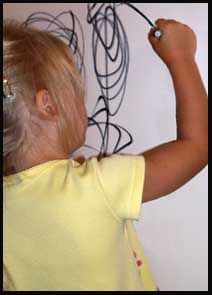Toddlers love the sounds of a pounding
crayon and the
magic of their markings on an unsuspecting wall. They experience joy from the
feel of the motion and surprising appearance of
the line. At this age, discovery is their job. This activity grows
out of their innate learning instincts. While the damage to a wall may
disappoint and even anger an adult caregiver, children at this age cannot be
blamed for our lack of adult understanding, guidance and supervision.
Some children are scolded for scribbling on
the walls. Some children are even prohibited from
using markers and crayons. These approaches could have negative
effects on their sense of self-worth, their visual intelligence, their
kinesthetic (muscle coordination) development, and possibly slow their readiness for school. If they are not allowed to scribble, their creative expressiveness
may lack an important outlet. Scribbling is such a universal urge that we assume it to be an essential building block in the
development of expressiveness, eye-hand coordination, imagination, and
the development of the visualization areas within the brain that are
essential to healthy learning and development.
Learning responsibility in a childproof environment
Children do need to care for their environments by learning to be careful
about where they make marks. When we childproof everything, we
also eliminate chances for children to make bad choices from which to
learn. When there is no chance of a small mistake, there is little
chance to learn. Sooner or later, every person makes mistakes. If we have learned from appropriately gentle and empathic responses to our small mistakes,
we will know how to make better choices when we make more serious mistakes. Of course, in matters of health and safety, we need to make things childproof. However, in matters that merely protect our easily repaired property
values there are real benefits in allowing for mistakes that in turn
provide chances to learn. It is not easy to learn responsibility without
a chance to practice.
Learning
to Care
Thoughtless and impulsive behavior
is natural for a young child. Wise parents realize this and look
for positive ways to motivate responsible and more "grown up" types
of behavior. A wise parent is clear and consistent about caring
for the child first and caring for property second. A wise parent
also knows that children who learn to care about things and people
will be the better for it. Learning to care is to be human. We are each defined by what we care about. The fact that it is better
to care for people than for things does not negate the need to learn
to care for things. Learning to care for things can be an important
habit that is consistent with caring for people.
Appropriate disciplinary responses to build
a healthy personality and strong character
If
a child inappropriately scribbles on the walls, we can get angry
and punitive. Or, we can express profound sadness and disappointment. While these are both understood by the child to be negative responses
to a negative act, the sad response will be much more nurturing than
the angry response. The sad response can be an honest and consistent
affirmation of our love for the child while honestly communicating the
child's need to be more thoughtful and caring. The angry response
tends to cancel the natural love between parent and child. Children instinctively imitate. Angry
responses from parents are apt to foster belligerence and rebellion. Empathic responses are more likely to foster empathic behavior. There are many reasons that
some children are "difficult", but parents who thoughtlessly respond
with anger and punishment are doing their part to create bad behavior
or festering hostilities that are apt to erupt in unexpected and uncontrollable ways.
Creative
positive responses
In
addition to being clear about how sad it makes us, if a child scribbles on the wall or makes
some other mistake, a wise, empathic, and creative parent immediately provides
an alternative positive and redemptive face saving behavior. This may consist
of inviting
the child to use the acceptable places and materials that have been
provided for scribbling when the urge comes. This clarifies
that scribbling is good, but only the place choice was not good. Children are often able to think of good alternatives if they are asked. They remember the good alternatives best if we recognize and affirm their good choices, telling them why we think their choices are good.
Positive
alternatives include the provision of large inexpensive pads of paper
and crayons or markers. Another approach is to install
inexpensive white board on the lower portion of certain walls. Provide child-safe markers that do not emit toxic
vapors. Parents who express pleasure when
the child remembers to draw at the designated places will experience fewer disappointments.
It
is generally okay to ask the child to assist in cleaning off the offending
marks so long as it is clear to the child that we really like the scribbling,
but we just do not like the place that the child selected to do the
scribbling. While helping with the cleaning seems like a good activity,
not too much can be made of it. We do not want to use the cleaning activity
as a reward for mistakes, nor would I want to make cleaning seem like
punishment.
Why would
we care about scribbling?
Scribbling
is a very important developmental task. It is an instinctive learning stage that helps the brain and body develop and build readiness for more the difficult tasks that are learned later. Children who lack a natural
urge to scribble may have been chastised or ridiculed rather than praised for
their experimental efforts. Unfortunately, these children are being retarded
in their natural development to be expressive. The brain's ability
to develop processing of visual materials may suffer. The
child's eye-hand coordination skills may be slowed. Just as crawling obviously
leads to walking, scribbling leads to drawing. Scribbling not only leads to drawing, scribbling provides essential
brain development leading to other advanced mental capacities and physical coordination abilities. For a child's intellect and personality
to develop, there needs to be opportunities to explore, be curious, and be
rewarded for this with recognition and praise that tells them why you are praising them. The affirmation can include telling them where you like them to scribble (when it has happened at a good place).
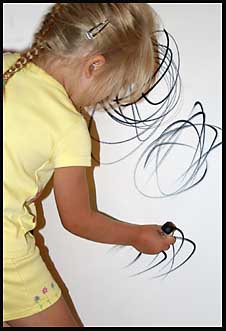 |
How can we
encourage scribbling?
Often a toddler's first scribbles start by pounding something like a crayon on piece of paper. The toddler is empowered and encouraged by hearing the sounds of the pounding. Since a crayon is apt to make marks. Upon noticing the marks, the child visually discovers cause and effect. This leads to more auditory pounding, more visual marks, and more discoveries. Parents can affirm both the sound and the marks to encourage them.
I never draw pictures for toddlers because adult drawings can discourage them from scribbling or drawing. These adult visual examples are too difficult. However, I find that when I pound a crayon on paper, they love to imitate me. Our crayon pounding is a kind of back and forth chatter or game as we take turns with our crayons making rhythmic sounds and imitating each other.
|
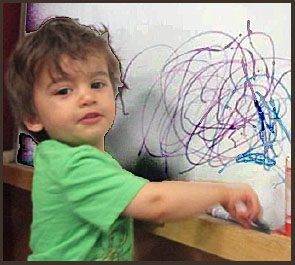 |
LEFT: At 21 months, a boy who has had many free play opportunities enjoys scribbling on a white board easel using markers that are safe for toddlers.
At some point he will begin to name his work and tell stories about his "pictures". When this happens, it probably indicates that he is beginning to think in more complex ways. |
|
Scribbling for a toddler is more about action and motion
than about creating a product. It is playing. It is process. It is activity. We encourage scribbling by providing a place and materials, by acknowledging
the work, and by discussing the work in a nonjudgmental descriptive ways. Therefore, I might say, "Wow, this looks like
you are having fun. Your crayon is really going fast." As
the child gets closer to the stage of image making, they are becoming accidental artists. I might say,
"This part looks neat, can you tell me about it?" As their thinking advances, they may invent imaginary stories for me. Soon their drawings will begin to show subject matter. Such inventive thinking is good brain practice for thinking of possible scenarios. I avoid asking, "What is it?" To me, this would be less affirmative than my invitation to tell me about it.
As
children become verbal and are able describe their work, their minds
are learning to think in imaginary and abstract ways. Their ability to imagine scenarios is a key aspect of their ability to do creative thinking and problem solving. |
|
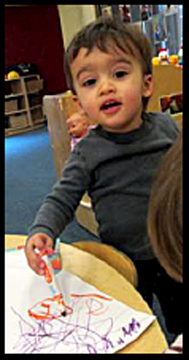
ABOVE: The same toddler at age16 months, enjoys scribbling on paper withwaterbase marker pens.
|
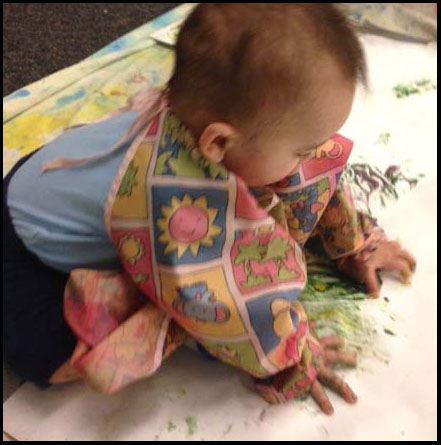 |
|
LEFT: The same boy as shown above is shown here at about six months. At this age, he would not easily be able to hold a crayon, but he enjoys the feel of things and may be discovering that his hands can leave evidence. A child this age is probably not learning to use imagination, but instinctively enjoys creating tactile, olfactory, and auditory sensory experiences. When infants gain affirmation for their exploratory play, they are empowered to self-initiate more exploration, more play, and more learning. |
For
the rest of our lives it is our imaginations that allow us to
predict the consequences of our actions. Our imaginations allow us to be creative, to empathize, to invent, to solve
everyday problems, and to make the world a better more joyous
place those we care about and for ourselves. Our imaginations
help us avoid thoughtless acts that bring sadness from those we
care about.
Not all educators say that it is important to provide tactile play such as playing with food at such a young age. It may encourage a child's spirit of discovery. Being positive and affirmative encourages the child to explore and learn. However, caregivers who scold them for annoyances or cultural offences are diminishing a child's exploratory play and discoveries. Wise caregivers teach play choices by substituting positive and interesting creative play choices that are safe instead of undesirable behavior choices that occur. Even bad situations can remain affirmative. They need positive alternatives and unfailing affirmation. Infants and toddlers have an instinct to explore and imitate, but cannot yet understand or empathize.
Being positive and affirmative while offering good choices encourages the child to explore and learn about better choices. On the other hand, babies will likely become limited in their creative thinking and learning abilities if they have caregivers who scold them for mere annoyances. Wise caregivers teach children how to make better play choices by substituting positive and interesting creative play options to replace "bad" or undesirable behavior situations.
1) Hart and Risley found parents that did the least talking to their babies had children who had the greatest learning difficulties in school. Parents with failing children had also used fewer affirmatives and more prohibitions such as 'stop it' and 'no' during infancy and preschool ages.
For infants and toddlers it is important to hold them, actively converse with them, look at books together, give positive responses to the their responses, and encourage their exploratory play. Scribbling can provide opportunities to give verbal affirmation, ask questions to enhance imagination, and it is a good example of exploratory play.
What size paper is best?
Generally, large paper sizes are good, but not essential. A remainder of a big roll of white paper from a newspaper company is often given free to parents and teachers. However, there are times and places when very small paper works very well. The scribbles in this video were done in 3 x 4 inch sketchbook by a 31 month old boy while attending a wedding ceremony. The video is less than two minutes and shows some of a series of 12 scribbles on a small sketchpad by this toddler. He is working on the floor. By the end of this practice learning activity, I asked him if he would like to draw a boy. You see his drawing of person with a ballpoint pen on 3 x 4 inch paper. In this video we see him move from the scribbling stage to his early symbol stage (also called pre schematic stage). His small muscle skills are quite impressive for his age. At one point we see his younger sister taking an interest in what he is doing. She is still one, but also apt to imitate and enjoy
scribbling soon.
Also see:
Eleven Questions and Reflections on Learning to Draw as Preschoolers (the author brings two chickens into a preschool drawing session) 2014
|
Stages of
Scribbling
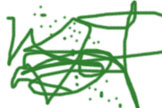
Disordered
(first scribbles)
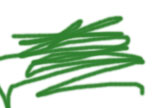
side to side or up and down sribbling
Longitudinal
(a little more advanced)

Circular Scribbling
(wow, what skill)

Naming of the Scribble
(thinking)
(becoming verbal)
(becoming symbolic)
|
Motivation
Provide Materials
Use noise questions
Use kinetic
questions
Do you like the noise?
Do you hear it go bang bang?
Does your marker like to dance?
Does the
crayon like to skate?
How fast can it spin around?
Use direction
questions
Does the crayon go up the paper?
Down the
paper?
Use size and color
questions for visual awareness and thinking/feeling
Use shape questions:
Does the marker make a circle?
Utilize sounds,
noises, and music.
Do not
worry about "pictures" because for the
child much of scribbling is pre-visual.
It is more about sound, motion, and action.
|
Materials
For growth, materials
need good line contrast.
Maximize use of
Dark and Bright
on white.
Examples are:
Markers, Crayons
Thick Paints
firm bristle brushes
Clay and similar modeling
materials, wet chalk
on dark paper
Wet Sand.
Blocks - natural
and colored wood.
Sorting sets of Color,
Texture, Shape.
Puzzles.
Minimize use of transparent watercolor, soft hair brushes, and
finger-paints because they are too subtle, harder to see, and less effective in
discovering the connection between action and result (eye/hand connection).
The more subtle materials are good to use with older children who have already discovered eye-hand connections. They are old enough to appreciate the visual nuances of subtle materials.
|
For More Growth
Ask for the story of the picture.
Encourage verbalization,
imagination, & explanation.
Ask about under, over,
which is bigger, smaller, sad and happy.
Ask if there is any
more or anything else that they want to add?
Did you forget anything?
Express your appreciation and thank the child for helping you look at their scribbles.
Ask, "Where should I add your name?" It belongs to the child, so allow the child make all the choices. Thinking is learned by doing it for ourselves.
to>introduction
to>preschematic
picture
to>thinking
picture
to>x-ray
picture
to>quest
for order
to>scribble
information
preschematic
information
to>schematic
information
|
All rights reserved. This page © Marvin Bartel.
For permission to make copies or handouts, contact the author.
Sources:
1) Hart, B., & Risley, R. T. (1995). Meaningful differences in the everyday experience of young American children. Baltimore: Paul H. Brookes. For an online Hart and Risley chart showing the comparisons of affirmations and prohibitions experienced by pre-school children in the homes of different groups see this U. of Oregon website.
http://reading.uoregon.edu/big_ideas/voc/voc_what.php
Many authors and researchers in art
education have written about the stages of artistic development.
2) Viktor Lowenfeld made many observations and described the stages in
his book: Creative and Mental Growth. The 4th edition
of Creative and Mental Growth by Viktor Lowenfeld and W. Lambert Brittain. 1964 includes a summary with charts describing the development stages in Chapter 13.
pages 395 to 402.
More Related Links by Bartel:
how to draw an orchid at age four and three-quarters
more about preschool art
links on learning to think artistically and creatively
About the author. At this update I am a parent of three and a grandfather of six. I was an art teacher for over 40 years and I maintain an active clayart studio practice and work as a consultant in the area of children and their art. I love to get down with kids and encourage them to scribble and draw for me or show me what they can make from a piece of clay. I volunteer as a drawing teacher for 1st and 2nd graders at our Boys and Girls Club. I share these essays because I become very sad when a child's self-confidence has been undercut by adults who have either done too much for the child or have not approved the child's natural and honest efforts. In the saddest cases a child's experimentation has been prohibited and punished. I am sad when they wait for me to show them how to scribble or draw something because they have been made to feel that their own instinctive explorations and abilities to see are not good enough. For older children who wish to practice ways to see better to draw better, I have an online book with self-instruction ideas they can choose. -- mb
Marvin Bartel, Ed.D. Art Education - biography ---- Contact the author
|
